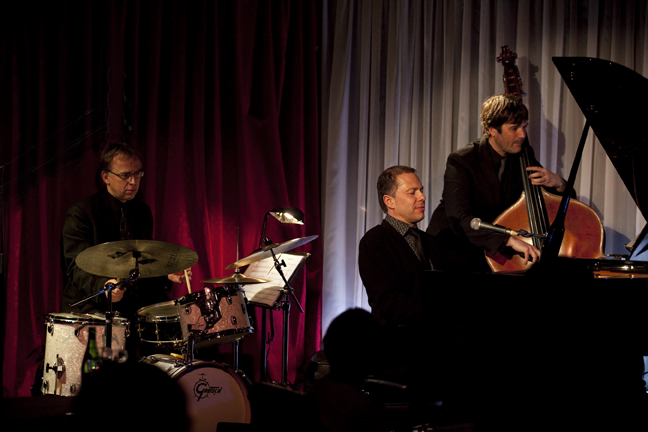
Halfway 2025: How to read two quarters under Trump 2.0
The mid-year economic outlook: How to read the first two quarters of Trump...
June 28, 2023 • by Dominic Alldis in Leadership
How can you give individual players in your team greater autonomy to achieve your company’s goals? Dominic Alldis shares how both classical and jazz quartets work together to deliver excellence....
Have you ever wondered what it might be like to be a professional musician playing the piano, violin, double bass or drums in a band? Or maybe conducting an orchestra, exerting your influence over 100 or more musical experts using silent hand gestures, helping to transform what would otherwise be an ordinary performance into something extraordinary?
Or imagine what it would be like to play in a symphony orchestra, surrounded by so much energy, excitement, talent, and expertise.
What if your work could feel like that?

In business, you interact, collaborate, and engage with each other around a common purpose which is to deliver exceptional performances for your colleagues, clients, and customers. On the one hand, you need to maintain corporate reliability and strategic alignment. On the other, you need to foster creativity and innovation, which means giving your people greater autonomy and accountability. These can often seem like two conflicting imperatives, yet you need to find a way to do both if you want your business to thrive.
In my work with organizations, I help leaders think about how they communicate and inspire others through the lens of music. One way is to have them explore two very different musical forms: a classical string quartet and a jazz band. These two contrasting cultures provide a valuable metaphor for effective communication in the workplace. Through exploring the similarities and differences between the two approaches, they start to think about their own challenges in new ways.
You need to prepare and let ideas evolve. You need to respect each other’s opinions, discuss new ideas and take turns at implementing different approaches.
Let’s first consider the classical approach. When we think of a string quartet (two violins, a viola, and a cello), we think of technical precision, intense listening, and musical excellence. Their aim is to realize a composer’s intentions through careful preparation, leading to a superlative performance.
What makes the process so interesting is that even though the notes on the page have been fixed by the composer, there are still so many ways of interpreting them – when to play faster or slower, what to emphasize, which instrument should lead while the others support. The same is true with an orchestra, where the same symphony can sound completely different when played by a different orchestra and conductor.
How do things work differently in a jazz quartet? A jazz performance typically involves a small group of musicians improvising around a theme with clearly defined boundaries and constraints. Their aim is to produce something new and original. Here you have four individuals engaged in a spontaneous musical conversation, building on each other’s ideas, embracing experimentation and risk-taking to engender a rich flow of creative ideas. The music may sound more turbulent and less certain than what you hear with the classical quartet, but it is also exciting and full of creative possibilities.
Some of you might find the lack of certainty unsettling. No one knows what’s going to happen next, but embracing uncertainty can also be an exciting journey. We may not know where we’re going, but we know where we’re coming from.

Finally, how might these two cultures learn from each other? How can they co-exist, collaborate and synergize to enhance one another’s performance? In the business context, where you are looking to balance creativity with discipline, what structures are needed to make this possible?
Here are four principles, drawn directly from my experience in the musical world:
Fine performances can only be achieved through careful preparation. In musical terms this is called rehearsal. Firstly, you need to practice at home to build the confidence, virtuosity, and agility needed to perform a variety of tasks. Then in rehearsal you can experiment with different ways of interpreting the music.

“You need to foster creativity and innovation, which means giving your people greater autonomy and accountability.”
Likewise, in business, you need to prepare and let ideas evolve. You need to respect each other’s opinions, discuss new ideas and take turns implementing different approaches. As a leader, you also need to cultivate an environment where you can make a comment about someone else’s performance and for it to be welcomed and taken constructively. Commit to this creative process and make the process fun!
In your business, then, think about how much creative freedom is appropriate to a given situation. For example, if you’ve ever listened to free jazz, you’ll know that when there is no structure, predetermined theme, key or rhythm, the result can be very chaotic, but it can also be sublime, unique and exceed everyone’s expectations. It’s thrilling to hear the expert musicians merely responding spontaneously to what they hear, which also takes great skill, discipline, and experience. Again, it’s all about listening and being curious, present, and patient. As we know, sometimes the best ideas take a while to emerge.
Finally, think about momentum in music and business. Jazz musicians like to get things going with a clear beat or ‘groove’ – it helps get the creative juices flowing. They then start to experiment and build on each other’s ideas to produce outstanding results.
So how can you benefit from both team cultures? What would happen if you brought a little more rigor and discipline into your improvisational model or a little more experimentation and spontaneity into your highly structured organization? Listen, experiment, and mix it up to keep it fresh. That way you stand a better chance of delighting your audience and getting the applause you deserve. A standing ovation rather than deafening silence!
This article is inspired by a keynote session at IMD’s signature Orchestrating Winning Performance program, which brings together executives from diverse sectors and geographies for a week of intense learning and sharing with IMD faculty and business experts.

Orchestral conductor, composer, jazz musician, founder of Music & Management Open
Dominic Alldis combines decades of experience performing internationally as a musician, with 20 years facilitating musical learning events for business audiences. He is a multi-talented and versatile performer, equally at home conducting symphony orchestras, improvising at the piano in jazz bands and teaching students at the Royal Academy of Music.

1 day ago • by Richard Baldwin in Leadership
The mid-year economic outlook: How to read the first two quarters of Trump...

July 4, 2025 • by Arturo Pasquel in Leadership
Susanne Hundsbæk-Pedersen, Global Head of Pharma Technical Operations at Roche, shares how she has navigated the various pivots in her career, and the importance of curiosity, optimism and energy. ...

July 3, 2025 • by Eric Quintane in Leadership
Entrepreneurial talent who work with other teams often run into trouble with their managers. Here are ways to get the most out of your ‘boundary spanners’...
 Audio available
Audio available
June 27, 2025 • by David Bach in Leadership
Business leaders today should identify their points of leverage – be it public influence, economic power, or industry collaboration – to quietly but effectively push back against policies that undermine democracy, said...
Explore first person business intelligence from top minds curated for a global executive audience